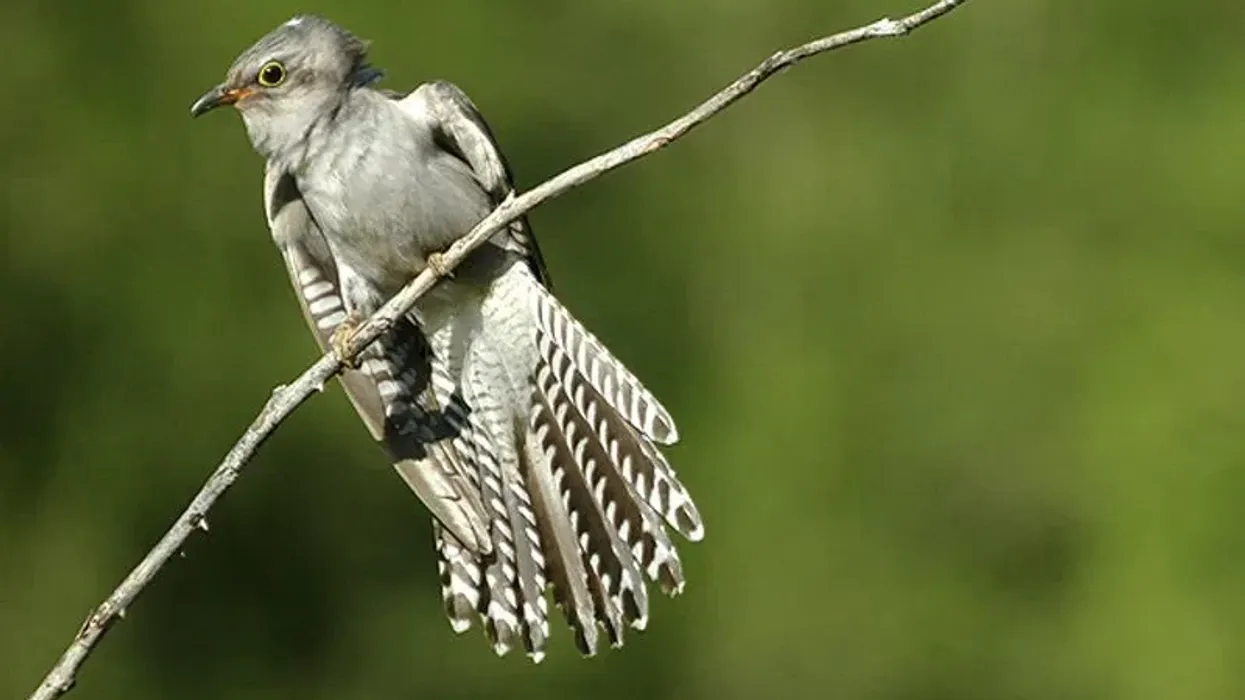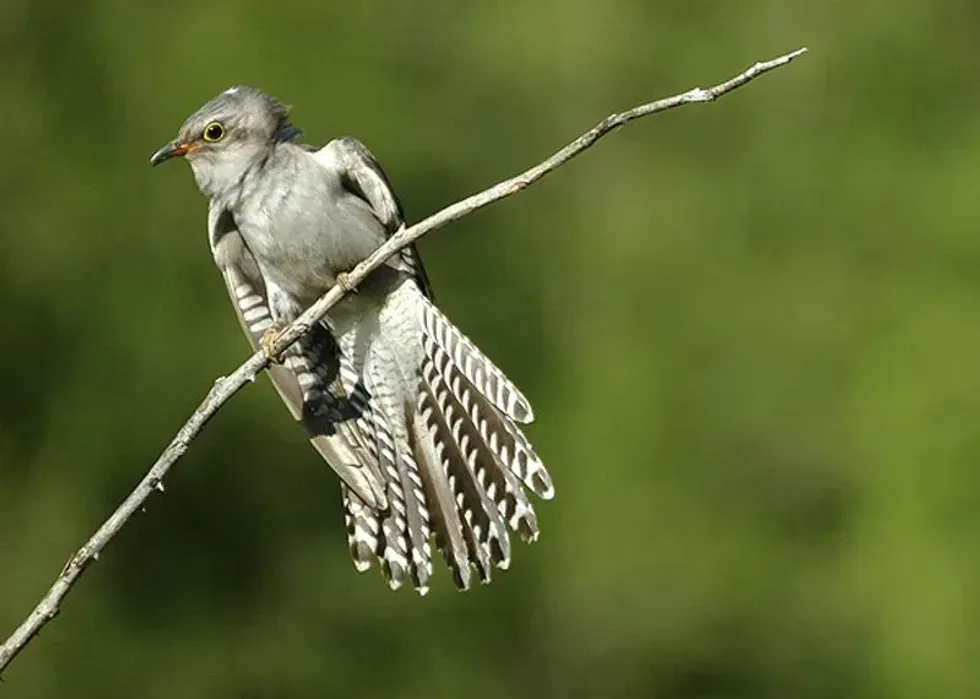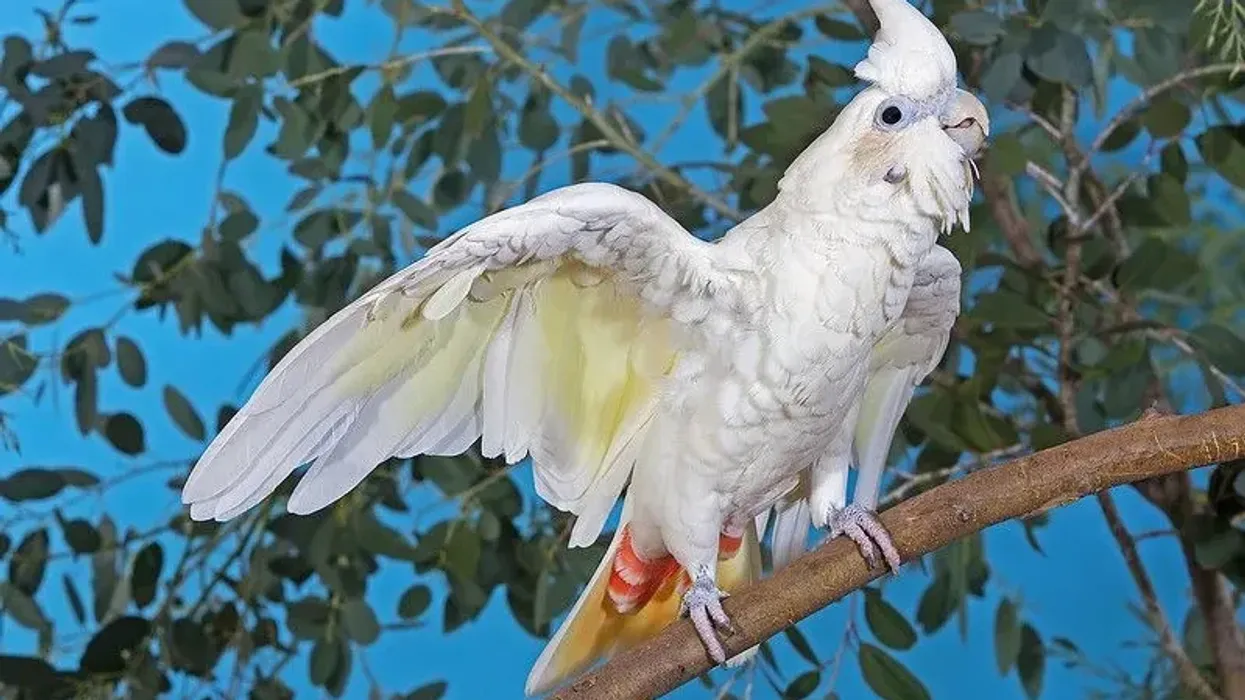A pallid cuckoo (Cacomantis pallidus) is from the family Cuculidae and is found in Australia and Tasmania. They tend to spend their winter in the Northern Territory and central inland Australia, and migrate to the coastal region of Southeast Australia and Tasmania.
The habitat of the pallid cuckoo bird consists of mangrove forests, woodlands, shrublands, golf courses, farmlands, gardens, and pastoral country.
Mating occurs between July and December and this bird is known to be a brood parasite, meaning the pallid cuckoo lays its eggs in the nest of other birds and the chicks are reared by foster parents.
Baby cuckoos are abandoned by their original parents. The cuckoo eggs hatch earlier than other ones and the young cuckoos tend to force out the other eggs.
A pallid cuckoo has a dark bill and also a dark eye with a gold-colored ring around the eye and a dark, shadowy mark that extends from the eye to the neck. These cuckoos have a white spot on the nape.
It has olive-gray feet and toothing along the tail. During the flight, white and dark-colored bars are noticeable.
These birds can have light and dark-colored rufous morphs. Adult males tend to have brown-gray colored upperparts that include the head and neck, and the wing-coverts have large patches or spots.
Adult females have a barring on the chest and tend to have a patch on the hindneck. The diet of this cuckoo is just like other cuckoos, consisting of caterpillars. This species is classified as Least Concern.
This species is known to have a repetitive and monotonous call and is known by many names such as scale-bird, semitone-bird, and brain-fever bird. Cuckoos are wild and migratory birds and are not kept as pets.
In some places, it is believed a crime to own a cuckoo. The oriental cuckoo is considered to be a similar species.
Continue reading for more facts about this species and if you are interested, read about the black-billed cuckoo and toco toucan too.
Pallid Cuckoo Interesting Facts
What type of animal is a pallid cuckoo?
A pallid cuckoo is a type of bird. These cuckoos are considered special because of their name, the unique pallid cuckoo song or call, and also because they have pointed and long wings.
What class of animal does a pallid cuckoo belong to?
A pallid cuckoo is categorized under the class of Aves.
How many pallid cuckoos are there in the world?
There is no estimation available for the global population of this species.
Where does a pallid cuckoo live?
The population of pallid cuckoos is distributed in the range of Australia and Tasmania. They winter in the Northern Territory and central inland Australia, and migrate to the coastal regions of southeast Australia and Tasmania.
It has been recorded that these birds also migrate to Papua New Guinea and the Timor Islands during winters. Some people believe that the pallid cuckoo is endemic to Tasmania.
What is a pallid cuckoo's habitat?
The habitat of the pallid cuckoo consists of mangrove forests, woodlands, shrublands, golf courses, farmlands, gardens, and pastoral country. This cuckoo is known to prefer scattered under-story where it can easily hunt for prey.
Who does the pallid cuckoo live with?
Not much is known about whether these birds are solitary or prefer living in groups or pairs.
How long does a pallid cuckoo live?
The pallid cuckoo life expectancy is not known.
How do they reproduce?
In between the months of July and December, the breeding of pallid cuckoo occurs. This species is known to be a brood parasite, meaning the pallid cuckoo lays its eggs in the nest of other birds like flycatchers, honeyeaters, and whistlers.
Other common birds include willy wagtails and hooded robins. Pallid cuckoo eggs hatch first and push the other eggs out of the nest.
Just like other cuckoos, the young ones of pallid cuckoos are also known to force the eggs of other birds out of the nest after they hatch.
What is their conservation status?
These birds have a conservation status of Least Concern according to the IUCN. The population of some species of cuckoos in some areas is declining, so they might be considered rare in some areas. In general, populations of cuckoos are not threatened.
Pallid Cuckoo Fun Facts
What does a pallid cuckoo look like?
The most prominent features of the pallid cuckoo include a dark-colored bill, a gold-colored ring around the eye, and a dark, shadowy mark that extends from the eye to the neck. These cuckoos have a white spot on the nape.
These birds have olive-gray feet and toothing along the tail. During flight, white and dark-colored bars are noticeable. These birds can have either light or dark-colored rufous morphs.
Adult males tend to have brown-gray colored upperparts that include the head and neck, and the wing-coverts have large patches or spots. Adult females have a barring on the chest and tend to have a patch on the hindneck.
How cute are they?
These birds are considered cute because of their physical appearance.
How do they communicate?
Communication takes place through different types of sounds and calls produced by this species, similar to other birds. The call of this bird can be explained as a repetitive series of whistled notes that are quite loud and can go on for long periods which also tend to go higher in pitch consistently.
How big is a pallid cuckoo?
The length ranges from 11-13 in (28-33 cm). This bird is slightly smaller than a European robin, but larger than a burrowing owl.
How fast can a pallid cuckoo fly?
The speed of flying of this bird is not available. However, pallid cuckoo birds are migratory birds.
How much does a pallid cuckoo weigh?
The pallid cuckoo weight ranges from 2.3-4.05 oz (65-115 g).
What are the male and female names of the species?
Males and females of cuckoos do not have any particular names.
What would you call a baby pallid cuckoo?
Babies of birds in general, are known as chicks or young ones.
What do they eat?
Pallid cuckoos are known to feed on caterpillars, especially hairy ones but they also feed on other insects. They tend to prey from a low perch and then pounce on their prey on the ground.
Pallid cuckoos are hunted by raptors such as eagles.
Are they dangerous?
These birds are not considered dangerous.
Would they make a good pet?
Cuckoos are wild birds and are not suitable as pets. It is illegal to own cuckoos in some places.
Did you know...
It is believed that John Latham, an English Ornithologist, described this as a pale pigeon (Columba pallida) in 1801. The International Ornithological Committee gave this bird its official name, pallid cuckoo. Other names of this bird include scale-bird, semitone-bird, brain-fever bird, and unadorned cuckoo because of its monotonous call.
The family Cuculidae is known to have a distinguishing feature as the members have two inner toes that point in the forward direction and the two outer ones are known to point in the backwards direction.
It is easy to spot a pallid cuckoo in its habitat because of its gray-colored plumage and dark bark. They also tend to have a barred undertail.
The oriental cuckoo (Cacomantis saturatus) is considered to be a similar-sized species to the pallid cuckoo and there are only a few differences in the appearance of both species. The former is known to have considerably darker plumage and barring on the belly and lower breast.
The wings of pallid cuckoos are considered to be similar to other Australian cuckoo species.
Why are they called cuckoos?
It is believed that the name of this bird is onomatopoeic and has been derived from the distinct call of this bird.
How many eggs do pallid cuckoos lay?
The exact number of eggs laid by the pallid cuckoo is not known, but it is believed that cuckoos can lay around 12-22 eggs. Also, the pallid cuckoo does not build its own nest, but lays its eggs in the nests of other birds.
Here at Kidadl, we have carefully created lots of interesting family-friendly animal facts for everyone to discover! Learn more about some other birds from our green parakeet facts and macaw facts pages.
You can even occupy yourself at home by coloring in one of our free printable Pallid cuckoo coloring pages.










